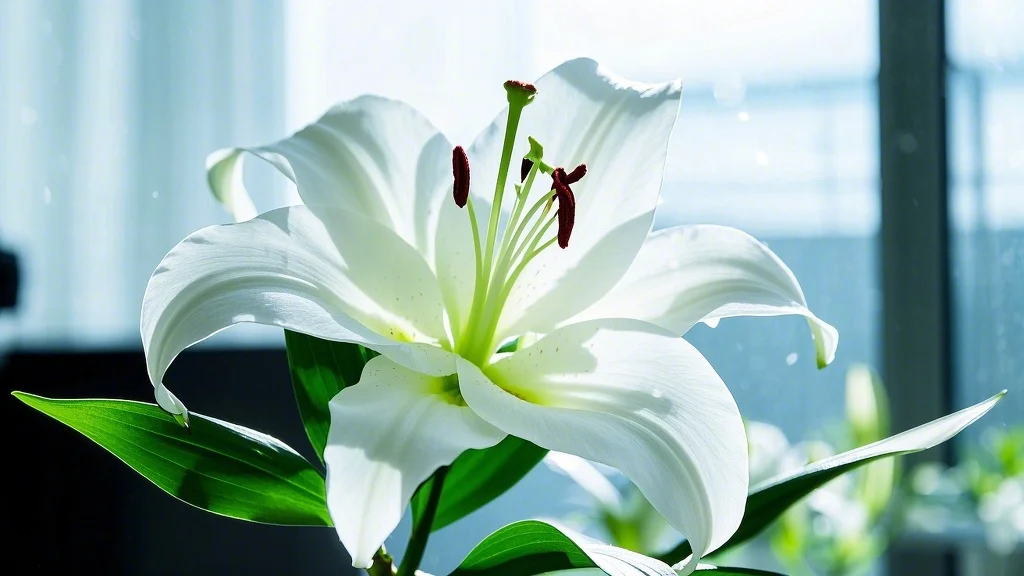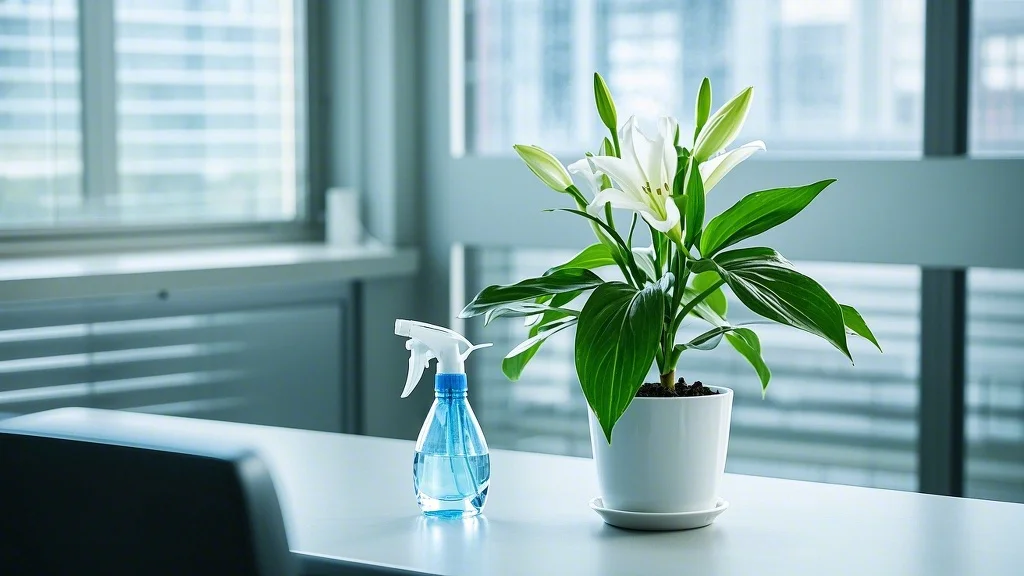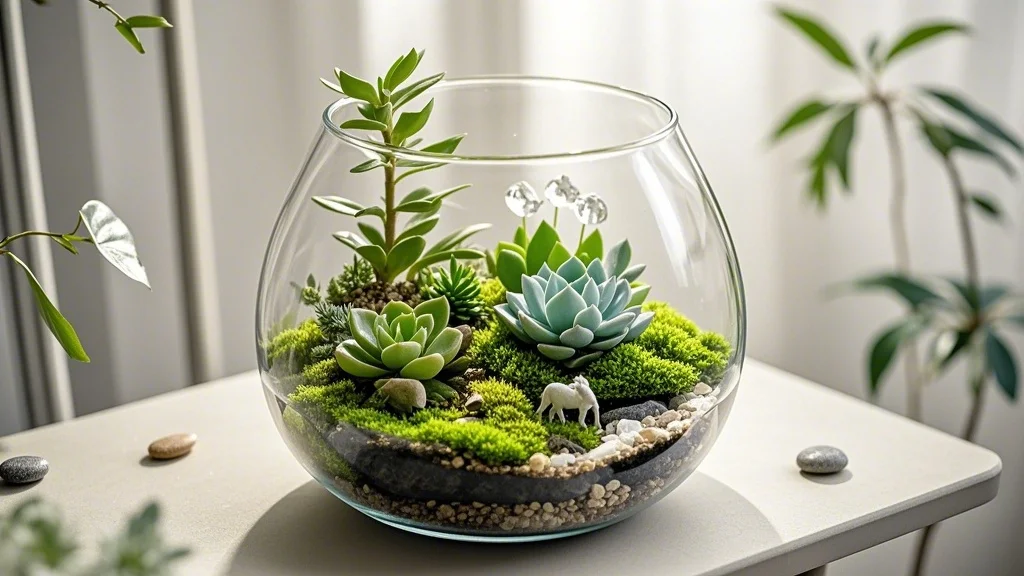The modern office environment often lacks one crucial element: nature. With fluorescent lighting, recycled air, and synthetic materials surrounding us, incorporating living plants can transform a sterile workspace into a more vibrant, healthy environment. Among the many options for office greenery, the peace lily (Spathiphyllum) stands out as an exceptional choice that combines aesthetic appeal with practical benefits.
Peace lilies are more than just attractive plants with their glossy dark green leaves and distinctive white blooms. They’re renowned for their air-purifying capabilities, low maintenance requirements, and ability to thrive in typical office conditions. Whether you’re an office manager looking to improve the workplace environment or an employee seeking to enhance your personal workspace, peace lilies offer a perfect blend of beauty and functionality.
Contents
Why Peace Lilies Excel in Office Environments

Adaptability to Office Conditions
Peace lilies have earned their reputation as ideal office plants for several compelling reasons:
- Low light tolerance: Unlike many flowering plants, peace lilies can flourish under the typical fluorescent lighting found in most offices. While they prefer indirect light, they adapt well to lower light conditions, making them suitable for spaces away from windows.
- Space efficiency: Available in various sizes, from compact desktop varieties to larger floor specimens, peace lilies can fit into virtually any office space configuration.
- Temperature resilience: Peace lilies thrive in the temperature range most offices maintain (65-80°F or 18-27°C), eliminating the need for special climate adjustments.
Air-Purifying Powerhouse
Perhaps the most compelling reason to introduce peace lilies to your office is their exceptional air-purifying capabilities. NASA’s Clean Air Study identified peace lilies as one of the most effective plants for removing indoor air pollutants, including:
- Benzene: Found in plastics, synthetic fibers, and some cleaning products
- Formaldehyde: Emitted from furniture, carpeting, and building materials
- Trichloroethylene: Present in printing inks, paints, and adhesives
- Xylene and toluene: Components in many office products and electronics
In addition to filtering these specific toxins, peace lilies help increase humidity levels, potentially reducing respiratory irritation and dry skin issues common in air-conditioned environments.
Visual and Psychological Benefits
Beyond their practical advantages, peace lilies contribute significantly to workplace aesthetics and employee wellbeing:
- The elegant white blooms provide a calming visual element that can reduce stress
- Their lush foliage adds a touch of nature that can boost mood and creativity
- As living elements in the workspace, they create focal points that break up monotonous office designs
Research consistently shows that employees working in environments with living plants report higher job satisfaction, increased productivity, and reduced absenteeism.
Comprehensive Peace Lily Care in Office Settings

Light Requirements
While adaptable to various lighting conditions, understanding your peace lily’s light preferences will ensure optimal health:
- Ideal condition: Bright, indirect light, such as near a north or east-facing window with filtered light
- Acceptable condition: Fluorescent office lighting, though blooming may be reduced
- Signs of inadequate light: Fewer flowers, stretched stems, or paler leaves
- Signs of excessive light: Yellow or brown leaf edges, wilting despite adequate water
For offices with minimal natural light, consider supplementing with full-spectrum desk lamps positioned 12-18 inches above the plant for a few hours daily.
Watering Practices
Peace lilies communicate their watering needs quite clearly, making them forgiving for busy office workers:
- When to water: When leaves begin to droop slightly (but before they become severely wilted)
- How to water: Thoroughly until water drains from the bottom, then empty the drainage tray
- Water quality: Preferably use filtered or room-temperature tap water that has sat overnight (peace lilies can be sensitive to chlorine and fluoride)
- Weekend considerations: A good Friday watering typically sustains the plant through the weekend
Pro tip: Rather than adhering to a rigid schedule, learn to “read” your peace lily’s needs. Slight drooping indicates it’s time to water, while perky leaves suggest sufficient moisture.
Humidity Management
Office environments, particularly those with central heating or air conditioning, often have low humidity levels that can challenge peace lilies:
- Ideal humidity: 40-60% (higher than most office environments)
- Simple solutions:
- Group multiple plants together to create a microclimate
- Place the pot on a pebble tray with water (ensuring the pot bottom doesn’t sit in water)
- Occasional misting of leaves (best done early in the day)
- Small desktop humidifiers for personal workspaces
Fertilization Schedule
Peace lilies in office settings require minimal fertilization:
- Frequency: Apply a balanced, water-soluble fertilizer at quarter-strength every 6-8 weeks during spring and summer
- Winter care: Suspend fertilization during fall and winter when growth naturally slows
- Warning signs of over-fertilization: Brown leaf tips, leaf burn, or salt buildup on soil surface
Potting and Repotting
The confined root system of peace lilies means they don’t require frequent repotting:
- Container selection: Choose pots with drainage holes and saucers to catch excess water
- Potting medium: Use a quality, well-draining potting mix formulated for indoor plants
- Repotting frequency: Every 2-3 years, or when roots become visible at the soil surface or drainage holes
- Best timing: Spring or early summer, when the plant is in active growth
Common Office-Specific Challenges
Several factors unique to office environments require special consideration:
- Weekend care: Peace lilies can typically survive a weekend without water, but for extended holidays, arrange for watering or consider self-watering systems
- Air conditioning drafts: Avoid placing plants directly in the path of heating or cooling vents
- Cleaning products: Some office cleaning chemicals can harm plants; consider covering plants during heavy cleaning sessions or requesting plant-safe products
- Pest management: Regularly inspect for pests, particularly if plants are brought in from home environments
Maximizing Air-Purifying Benefits
To optimize the air-purifying potential of peace lilies in your office:
Strategic Placement
- Near electronics: Position plants close to computers, printers, and other equipment that emit VOCs (volatile organic compounds)
- Personal breathing zone: Place smaller specimens on desks within 3-4 feet of workstations
- Problem areas: Target locations with poor ventilation or known air quality issues
- Quantity considerations: NASA research suggests one medium-sized plant per 100 square feet for optimal air filtration
Maintenance for Air Purification
- Dust removal: Gently wipe leaves with a damp cloth monthly to keep stomata (leaf pores) clear for maximum air filtering
- Leaf health: Promptly remove any yellowing or dead leaves that no longer contribute to air purification
- **Root which can lead to root rot and diminished plant function
Complementary Plants
For comprehensive air quality improvement, consider complementing peace lilies with other office-friendly air purifiers:
- Snake plants (Sansevieria): Excellent for removing nitrogen oxides and formaldehyde
- Spider plants (Chlorophytum): Effective against carbon monoxide and xylene
- Pothos (Epipremnum): Removes benzene and other VOCs
- ZZ plants (Zamioculcas): Tolerates neglect while filtering air
Troubleshooting Common Peace Lily Issues
Even with proper care, peace lilies may occasionally develop problems in office environments:
Leaf Problems
- Brown tips: Usually indicates low humidity, fluoride in water, or over-fertilization
- Solution: Increase humidity, use filtered water, and reduce fertilizer
- Yellowing leaves: Often caused by overwatering, poor drainage, or aging
- Solution: Allow soil to dry more between waterings and ensure proper drainage
- Drooping despite moist soil: May indicate root rot or temperature stress
- Solution: Check roots for signs of rot; relocate plant away from drafts or temperature extremes
Flowering Issues
- No blooms: Typically due to insufficient light or improper fertilization
- Solution: Move to brighter location (but not direct sun) and adjust fertilization schedule
- Green flowers: Young spathes (the “flowers”) start green and turn white; if they remain green, light levels may be too low
- Solution: Provide brighter indirect light
Pest Management in Office Settings
Office peace lilies occasionally encounter pests, requiring treatment methods appropriate for shared spaces:
- Spider mites: Indicated by fine webbing and stippled leaves
- Solution: Increase humidity; wipe leaves with mild soapy water solution
- Mealybugs: Appear as white, cottony clusters
- Solution: Remove with alcohol-dipped cotton swabs; apply insecticidal soap after hours
- Scale insects: Look for brown bumps on stems and leaf undersides
- Solution: Scrape off gently; treat with horticultural oil on weekends
When using any treatment, consider office occupants with sensitivities and apply treatments after hours or on weekends.
Creating a Peace Lily Program for Your Office
Implementation Strategies
For office managers looking to incorporate peace lilies systematically:
- Plant ambassador program: Designate volunteers to care for plants in their areas
- Maintenance schedule: Create a simple calendar for watering, cleaning, and fertilizing
- Care cards: Provide basic instruction cards to place near each plant
- Professional service: Consider a professional plant maintenance service for larger offices
Measuring Impact
To quantify the benefits of your office peace lily program:
- Air quality monitoring: Before-and-after measurements using simple air quality meters
- Employee surveys: Gather feedback on perceived air quality and workplace satisfaction
- Health metrics: Track absenteeism related to respiratory issues or headaches
- Productivity assessment: Measure performance in areas with and without plants
Conclusion
Peace lilies represent one of the most practical and beneficial plants for enhancing office environments. Their combination of air-purifying abilities, low maintenance requirements, and aesthetic appeal makes them uniquely suited to workplace settings. By introducing these remarkable plants to your office space and following the care guidelines outlined above, you can create a healthier, more pleasant work environment that benefits everyone.
Whether you’re greening an entire office complex or simply adding a plant to your personal workspace, peace lilies offer an accessible entry point to bringing nature’s benefits indoors. Their resilience in typical office conditions means even those without green thumbs can successfully incorporate these plants into their work lives.
As we continue to understand the importance of indoor air quality and biophilic design in workplace wellness, peace lilies stand as living proof that sometimes the most effective solutions are also the most elegant.
FAQs About Office Peace Lilies
Are peace lilies safe for offices with pets that occasionally visit?
Peace lilies contain calcium oxalate crystals that are toxic if ingested by pets. If office pets are present, place plants in inaccessible locations or consider pet-safe alternatives like spider plants or Boston ferns.
How do I transport a peace lily to the office without damage?
Protect from cold and drafts during transport by wrapping in paper or plastic, especially in winter. Secure the pot to prevent tipping, and water lightly the day before to ensure the plant isn’t stressed.
Can peace lilies help reduce workplace stress?
Research suggests that interacting with indoor plants, including peace lilies, can lower stress hormones and blood pressure. Their presence may contribute to a more relaxed work environment and improved mental wellbeing.
What’s the best way to propagate peace lilies for expanding our office greenery?
Division during repotting is the most reliable method. Gently separate the plant into sections, ensuring each has adequate roots and leaves, then pot individually in appropriate containers.
Do peace lilies affect office acoustics?
While individual plants have minimal impact, multiple peace lilies can help reduce noise by absorbing sound waves, potentially creating a quieter work environment, especially when placed strategically around noisy areas.








